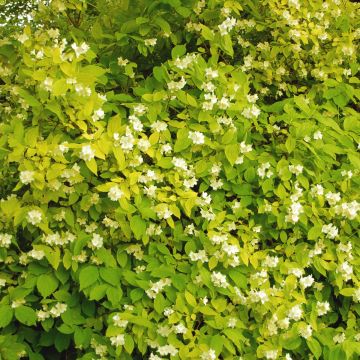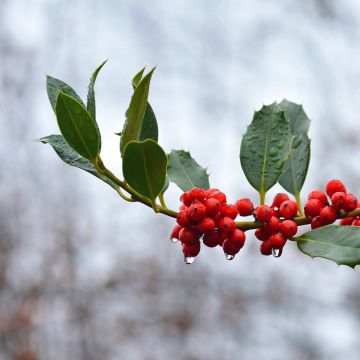

Seringat des jardins - Philadelphus coronarius Variegatus


Seringat des jardins - Philadelphus coronarius Variegatus


Seringat des jardins - Philadelphus coronarius Variegatus


Seringat panaché
View more pictures
Hide images

Emilie G.

I'm sorry, but the client review "seringeat" does not contain any text to be translated. If you have another customer review or any other text to be translated, please provide it and I will be happy to assist you in translating it into British English.
Emilie G. • 95 FR
Philadelphus coronarius Variegatus - Mock Orange
Philadelphus coronarius Variegatus
Mock Orange
Plant arrived in bad condition, I hope it will recover when planted. Package was damaged on the sides and the packaging was light.
celine, 07/06/2024
Special offer!
Receive a €20 voucher for any order over €90 (excluding delivery costs, credit notes, and plastic-free options)!
1- Add your favorite plants to your cart.
2- Once you have reached €90, confirm your order (you can even choose the delivery date!).
3- As soon as your order is shipped, you will receive an email containing your voucher code, valid for 3 months (90 days).
Your voucher is unique and can only be used once, for any order with a minimum value of €20, excluding delivery costs.
Can be combined with other current offers, non-divisible and non-refundable.
Home or relay delivery (depending on size and destination)
Schedule delivery date,
and select date in basket
This plant carries a 24 months recovery warranty
More information
We guarantee the quality of our plants for a full growing cycle, and will replace at our expense any plant that fails to recover under normal climatic and planting conditions.

Would this plant suit my garden?
Set up your Plantfit profile →
Description
The Philadelphus coronarius Variegatus is a deciduous bush with a remarkable flowering in late spring, creamy white, on a magnificent light green foliage variegated with cream, which will intoxicate the garden with its enchanting fragrance. Sublime!
Belonging to the Hydrangea family, the Philadelphus coronarius, also known as Seringat or Poet's Jasmine, is native to southern Europe and Asia Minor. Variegated Seringat is an ornamental deciduous bush with a shallow root system, whose brown bark tends to peel off with age. It forms an upright and rigid ball with abundant and vigorous growth. Its main branches are well erect, and its secondary branches are more arched and loose. Of medium size, it measures up to 2.50 m (8ft) in height and 2 m (7ft) in width. In late spring and early summer, it is adorned with clusters of single 4-petaled flowers, creamy white, 2.5 cm (1in) in diameter, with white and golden yellow stamens, highly fragrant. This Variegatus cultivar is characterised by an extremely decorative light green foliage irregularly margined with cream. Its slightly aromatic leaves are ovate and finely toothed, with a glaucous underside bearing some hairs towards the base, and measure from 4 to 9 cm (2 to 4in).
This Variegated Poet's Jasmine is suitable for all types of gardens. It is straightforward to grow and ideal for beginner gardeners; it enjoys being planted in sunny or semi-shaded positions in ordinary, even chalky soil. It has a relatively slow but regular growth, making it perfect as a standalone specimen, in the background of mixed borders, in association with other shrubs, in a flowering country hedge, or even grown in a container.
Consider planting it near the house, terrace, or pathways to enjoy its intense fragrance. Planting in partial shade will illuminate the garden with the green and cream colour of its foliage and the whiteness of its flowers. Create sumptuous foliage contrasts by placing it near other shrubs. As its flowering period is relatively short, consider associating it with shrubs that flower earlier or later (Deutzia, Buddleia, Forsythia, Caryopteris, False Aralia...). Allowing a clematis or a climbing rose with flexible branches to climb in its slightly rigid branches will give a wild and charming look to your seringat. Its white flowering also allows beautiful combinations of perennial plants with blue flowers (or white flowers for an evening garden).
In ancient Persia, the white and fragrant flowers of Philadelphus coronarius were used to make scented crowns.
This variety was awarded the Award of Garden Merit in 1993, which corresponds to the Gold Medal of the plant world, by the Royal Horticultural Society.
Report an error about the product description
Philadelphus coronarius Variegatus - Mock Orange in pictures




Plant habit
Flowering
Foliage
Botanical data
Philadelphus
coronarius
Variegatus
Hydrangeaceae
Mock Orange
Cultivar or hybrid
Other Philadelphus - Mock Orange
View all →Planting and care
The Philadelphus coronarius Variegatus, is straightforward to grow, requiring very little maintenance and accommodating; it is well suited to all gardens and ideal for beginner gardeners. Ordinary, poor, even limestone soil, not too dry or too wet, suits it. However, it will prefer fresh, well-drained and humus-rich soil. Very hardy, it can withstand temperatures as low as -20°C (1°F). Planting should be done in early spring or autumn, preferably in full sun or partial shade. Excessive heat exposure should be avoided in dry and hot climates. Flowering on the previous year's shoots, the Philadelphus should be pruned after flowering, in July-August, by shortening the flowering branches by one-third of their length. More severe pruning can be done every 2 to 3 years to keep it compact and floriferous. Do not hesitate to cut the old wood and long branches down to the base of the plant to encourage branching from the base. A resistant bush, it may, however, be prone to powdery mildew and black aphids.
Planting period
Intended location
Care
-
, onOrder confirmed
Reply from on Promesse de fleurs
Similar products
Haven't found what you were looking for?
Hardiness is the lowest winter temperature a plant can endure without suffering serious damage or even dying. However, hardiness is affected by location (a sheltered area, such as a patio), protection (winter cover) and soil type (hardiness is improved by well-drained soil).

Photo Sharing Terms & Conditions
In order to encourage gardeners to interact and share their experiences, Promesse de fleurs offers various media enabling content to be uploaded onto its Site - in particular via the ‘Photo sharing’ module.
The User agrees to refrain from:
- Posting any content that is illegal, prejudicial, insulting, racist, inciteful to hatred, revisionist, contrary to public decency, that infringes on privacy or on the privacy rights of third parties, in particular the publicity rights of persons and goods, intellectual property rights, or the right to privacy.
- Submitting content on behalf of a third party;
- Impersonate the identity of a third party and/or publish any personal information about a third party;
In general, the User undertakes to refrain from any unethical behaviour.
All Content (in particular text, comments, files, images, photos, videos, creative works, etc.), which may be subject to property or intellectual property rights, image or other private rights, shall remain the property of the User, subject to the limited rights granted by the terms of the licence granted by Promesse de fleurs as stated below. Users are at liberty to publish or not to publish such Content on the Site, notably via the ‘Photo Sharing’ facility, and accept that this Content shall be made public and freely accessible, notably on the Internet.
Users further acknowledge, undertake to have ,and guarantee that they hold all necessary rights and permissions to publish such material on the Site, in particular with regard to the legislation in force pertaining to any privacy, property, intellectual property, image, or contractual rights, or rights of any other nature. By publishing such Content on the Site, Users acknowledge accepting full liability as publishers of the Content within the meaning of the law, and grant Promesse de fleurs, free of charge, an inclusive, worldwide licence for the said Content for the entire duration of its publication, including all reproduction, representation, up/downloading, displaying, performing, transmission, and storage rights.
Users also grant permission for their name to be linked to the Content and accept that this link may not always be made available.
By engaging in posting material, Users consent to their Content becoming automatically accessible on the Internet, in particular on other sites and/or blogs and/or web pages of the Promesse de fleurs site, including in particular social pages and the Promesse de fleurs catalogue.
Users may secure the removal of entrusted content free of charge by issuing a simple request via our contact form.
The flowering period indicated on our website applies to countries and regions located in USDA zone 8 (France, the United Kingdom, Ireland, the Netherlands, etc.)
It will vary according to where you live:
- In zones 9 to 10 (Italy, Spain, Greece, etc.), flowering will occur about 2 to 4 weeks earlier.
- In zones 6 to 7 (Germany, Poland, Slovenia, and lower mountainous regions), flowering will be delayed by 2 to 3 weeks.
- In zone 5 (Central Europe, Scandinavia), blooming will be delayed by 3 to 5 weeks.
In temperate climates, pruning of spring-flowering shrubs (forsythia, spireas, etc.) should be done just after flowering.
Pruning of summer-flowering shrubs (Indian Lilac, Perovskia, etc.) can be done in winter or spring.
In cold regions as well as with frost-sensitive plants, avoid pruning too early when severe frosts may still occur.
The planting period indicated on our website applies to countries and regions located in USDA zone 8 (France, United Kingdom, Ireland, Netherlands).
It will vary according to where you live:
- In Mediterranean zones (Marseille, Madrid, Milan, etc.), autumn and winter are the best planting periods.
- In continental zones (Strasbourg, Munich, Vienna, etc.), delay planting by 2 to 3 weeks in spring and bring it forward by 2 to 4 weeks in autumn.
- In mountainous regions (the Alps, Pyrenees, Carpathians, etc.), it is best to plant in late spring (May-June) or late summer (August-September).
The harvesting period indicated on our website applies to countries and regions in USDA zone 8 (France, England, Ireland, the Netherlands).
In colder areas (Scandinavia, Poland, Austria...) fruit and vegetable harvests are likely to be delayed by 3-4 weeks.
In warmer areas (Italy, Spain, Greece, etc.), harvesting will probably take place earlier, depending on weather conditions.
The sowing periods indicated on our website apply to countries and regions within USDA Zone 8 (France, UK, Ireland, Netherlands).
In colder areas (Scandinavia, Poland, Austria...), delay any outdoor sowing by 3-4 weeks, or sow under glass.
In warmer climes (Italy, Spain, Greece, etc.), bring outdoor sowing forward by a few weeks.


















































